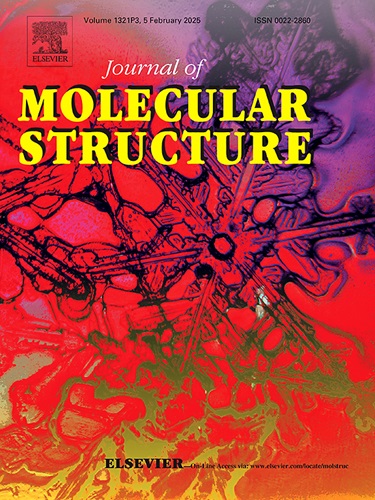Synthesis, crystallographic, spectroscopic, quantum chemical studies and anticancer activity of novel pyrazoline derivative
IF 4
2区 化学
Q2 CHEMISTRY, PHYSICAL
引用次数: 0
Abstract
In this study, a novel Pyrazoline derivative viz. 1-(3-(3, 4-dimethoxyphenyl)-7-methoxy-3, 3 a, 4, 5-tetrahydro-2H-benzo [g] indazol-2-yl) ethan-1-one was synthesized and characterized using nuclear magnetic resonance (NMR), Fourier transforms infrared (FT-IR) spectroscopy and single-crystal X-ray diffraction. This compound was evaluated in a human cervical cancer cell line and showed significant anticancer activity. DFT quantum chemical calculations were performed to analyze the structural stability and electronic features. Intermolecular interactions were studied using Hirshfeld surfaces and fingerprint plots based on the X-ray diffraction data. The geometry was optimized at the B3LYP/6-31G(d, p) level and the calculated NMR chemical shifts were in good agreement with the experimental data. TD-DFT was employed to determine the electronic characteristics from the UV-visible spectrum. Additionally, Molecular Electrostatic Potential, Fukui Function, Nonlinear Optical Quality and Natural Bond Orbital analysis were performed to assess global reactivity parameters and other key properties.
新型吡唑啉衍生物的合成、晶体学、光谱学、量子化学研究及抗癌活性
本研究合成了一种新型吡唑啉衍生物1-(3-(3,4 -二甲氧基苯基)-7-甲氧基- 3,3 a, 4,5 -四氢- 2h -苯并[g]茚唑-2-基)乙比1- 1,并利用核磁共振(NMR)、傅里叶变换红外(FT-IR)光谱和单晶x射线衍射对其进行了表征。该化合物在人宫颈癌细胞系中表现出明显的抗癌活性。通过DFT量子化学计算分析了其结构稳定性和电子特性。利用Hirshfeld曲面和基于x射线衍射数据的指纹图谱研究了分子间相互作用。几何结构在B3LYP/6-31G(d, p)水平上进行了优化,计算得到的核磁共振化学位移与实验数据吻合较好。采用TD-DFT从紫外可见光谱中测定电子特性。此外,通过分子静电势、福井函数、非线性光学质量和自然键轨道分析来评估整体反应性参数和其他关键性质。
本文章由计算机程序翻译,如有差异,请以英文原文为准。
求助全文
约1分钟内获得全文
求助全文
来源期刊

Journal of Molecular Structure
化学-物理化学
CiteScore
7.10
自引率
15.80%
发文量
2384
审稿时长
45 days
期刊介绍:
The Journal of Molecular Structure is dedicated to the publication of full-length articles and review papers, providing important new structural information on all types of chemical species including:
• Stable and unstable molecules in all types of environments (vapour, molecular beam, liquid, solution, liquid crystal, solid state, matrix-isolated, surface-absorbed etc.)
• Chemical intermediates
• Molecules in excited states
• Biological molecules
• Polymers.
The methods used may include any combination of spectroscopic and non-spectroscopic techniques, for example:
• Infrared spectroscopy (mid, far, near)
• Raman spectroscopy and non-linear Raman methods (CARS, etc.)
• Electronic absorption spectroscopy
• Optical rotatory dispersion and circular dichroism
• Fluorescence and phosphorescence techniques
• Electron spectroscopies (PES, XPS), EXAFS, etc.
• Microwave spectroscopy
• Electron diffraction
• NMR and ESR spectroscopies
• Mössbauer spectroscopy
• X-ray crystallography
• Charge Density Analyses
• Computational Studies (supplementing experimental methods)
We encourage publications combining theoretical and experimental approaches. The structural insights gained by the studies should be correlated with the properties, activity and/ or reactivity of the molecule under investigation and the relevance of this molecule and its implications should be discussed.
 求助内容:
求助内容: 应助结果提醒方式:
应助结果提醒方式:


